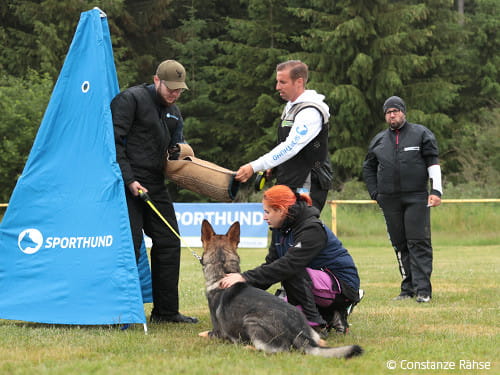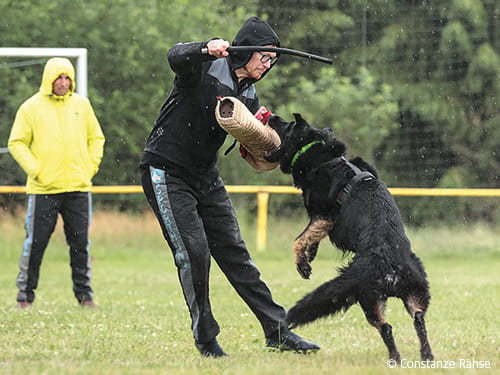Knowledge creates responsibility
The dog needs to bite hard and hammer away for the hold and bark! Okay, but he also has to be able to be called off and to be led easily. And to let go of the sleeve when you tell him to. But is that all that IGP protection training is about? Or is the devil perhaps in the details?
One of those people with an eye for detail in protection is Yannick Kayser. At his side, not only in real life but also in dog sports, is his partner Anne Eisemann. The two work together perfectly in their seminars and workshops. On June 23, participants of the Sporthund Praxistreff at TSG Schlegel benefitted from their precise analysis of what exactly happens in each exercise in protection, of the learning theory processes that affect the dog, and of the emotions that come into play. Attendees of the workshop showed up with different levels of experience – all the way from a beginner who wore a sleeve for the first time, to the experienced decoy who was off to championship selection the next day.
Yannick was kind enough to give me insight into his philosophy on protection training, so that we can all share in his wealth of knowledge.
Protection training needs be clearly structured
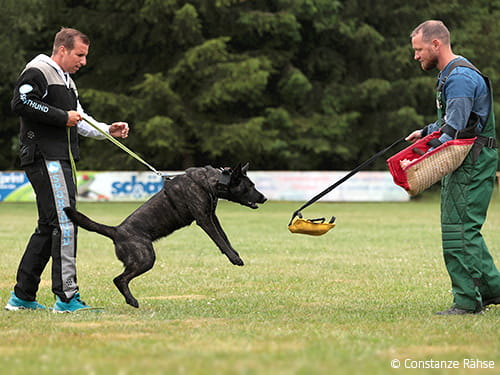
Yannick's concept is based on encouraging prey drive and aggression to the exact degree that the handler can control it. "I don't take dogs to levels of drive that are then difficult to manage," Yannick explains to me right at the beginning of our conversation. That is not to say he does not always strive to bring out the best. "When I have a suitable dog-handler team, of course I try to get into maximum drive levels, but impulse control constantly has to be present, so that the handler maintains control of the dog at all times. The bottom line is that everyone gets more out of it this way. Without adequate control of the dog, no one is going to win competitions."
Of course, right from the start Yannick focuses on deep grips, clean drive switches, and makes sure not to create unnecessary conflict that would have a negative effect on training. Things get exciting when we get into these details, because – as we said earlier - that is where the devil is.
"For me, everything always has to make sense in terms of learning theory. The four quadrants of operant conditioning play an important role here: positive and negative reinforcement, and positive and negative punishment. All four quadrants are used in a measured and healthy way."
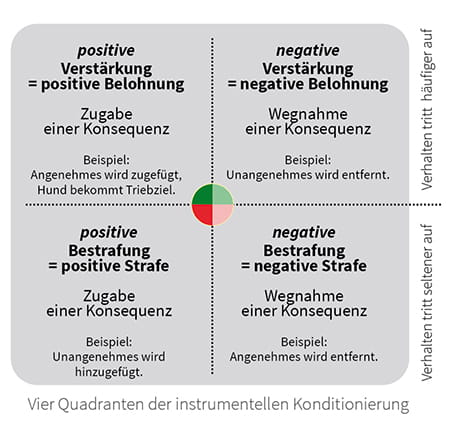
Yannick‘s methods vary, and his approach completely depends on the dog and handler in front of him, always looking for ways to best move the individual team forward.
"My first choice in puppy training is helper chasing (German: „Helfertreiben“). If I have a dog who has already developed the expectation that he will get a prey object from the helper, then I am not going to be able to get him into the mindset that I am looking to create. So to me, there is only one training sequence that makes sense in regards to learning theory: first, helper chasing to lay the foundation, and then molding prey drive on top of that. The former is based on negative reinforcement (something unpleasant stops) and the latter builds the expectation for a positive reinforcer (something pleasant is added). If I want to combine the two, the only reasonable way to do it is to let a positive reinforcer follow a negative reinforcer, but never the other way around."
"So our first approach is helper chasing. The dog needs to show enthusiasm in engaging with and controlling the helper within a few training sessions. If it does not, then I change my approach and choose to build via prey."
Impulse control promotes learning
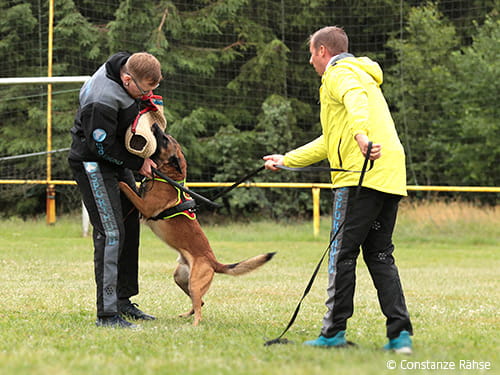
Yannick believes it is important to develop the dog's impulse control from the start. "Every dog I train takes food during protection training. To me, that's the first form of impulse control in puppyhood. As soon as I recognize that a dog shows up to training with certain expectations already in place in regards to helper chasing, I immediately introduce impulse control. The food the dog has to take in protection is positive reinforcement. But it is only that if the dog perceives it as such. The moment the dog is not interested in food, I change the whole story and turn it into negative reinforcement. I communicate to the dog that nothing will progress unless he takes food. This is the first form of impulse control. Eating is such a simple thing - any puppy can do it. He doesn't need to have learned anything to do that. I introduce this so that the dog learns to calm down, even in the presence of the decoy. Only when he is able to show me that off-switch and that calmness, do we continue with helper chasing or prey work."
"Impulse control means the dog has to decide: He needs to restrain himself and abstain from behavior which is innately rewarding to him," Yannick further explains. "That's why at this point, I'm not a fan of back-tying or even leash work in general. It often creates confusion because the handler unconsciously uses the leash to send signals or to prevent mistakes. Roughly speaking, there are two mistakes. The first one is lack of understanding in training, which means I have to help the dog avoid mistakes in order to learn something. The second mistake is lack of impulse control. This is a mistake that we can’t avoid if we can want to eliminate it. This is a mistake that needs to be made. Only then can the dog learn to not opt for this behavior again in the future. My dog handlers must therefore always learn to control the leash. That means the leash is on the dog, but we’re handling the dog as if it were not there. If the dog makes a mistake, we correct with our voice and body language. He has to learn to sit freely - without leash pressure."
Handlers who work with Yannick regularly also have to do a little homework in preparation for protection.
Barking at the handler for prey complements helper chasing
"Technically, the dogs learn how to bark at the handler. This takes place parallel to the dog being built up via helper chasing. We primarily use food for this, and use prey only when appropriate. The handler blocks food or prey, so that the dog gets frustrated and starts barking. This usually works very well. However, if I have a dog that doesn‘t get loud in response to this conflict, but reacts with a replacement behavior instead, then this approach is not an option. Such a dog closes up and can't get to the desired barking that way."
As well, the dogs first learn how to out from the handler, outside of protection training, of course. "Before it's used in protection, the dogs have already mastered outing, or swapping - that is, swap prey for food and then swap food for prey. The dogs are well-versed in this before they ever get to bite with me." By the way, Yannick recommends that you avoid training the out with a ball on a rope.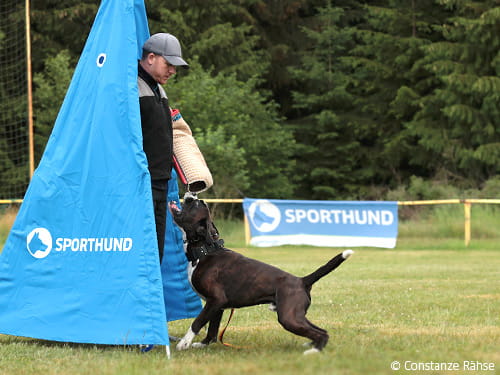
"If you perform the out exercise with a ball on a rope and you hold on to the rope, it creates an instance of negative punishment every time the dog lets go of the ball, because the ball falls down, away from the dog. That means I’m conditioning negative punishment for opening the mouth. That is confusing for the dog. Instead I prefer to train the out with a tug: I convey to the dog that I want him to let go of the tug and keep a distance of about ten centimeters to it. It is impossible to do that with a ball on a rope, because the ball will move away from the dog. That creates a dog that always thinks forward (towards the prey), but I actually want the dog to think backwards when outing (away from the prey). That to me is why ball play often causes conflict."
So now a foundation for the out and for the hold and bark has been laid. How does Yannick then introduce protection training to the puppy?
"When I start helper chasing, I do it once a week for a certain period of time. Then I take a break of four to six weeks, so that the dog‘s personality can continue to develop. If everything goes well, I repeat this process two or three times and then between the seventh and twelfth month of age, I introduce prey - depending on the dog’s disposition.
Once they are ready, the very first thing the dogs learn is how to bite. The dog should forcefully push off the ground, open its mouth, and perform a full and firm bite with a steady grip. Only when the dog has mastered that do I introduce the more complex exercises such as the escape, etc.“
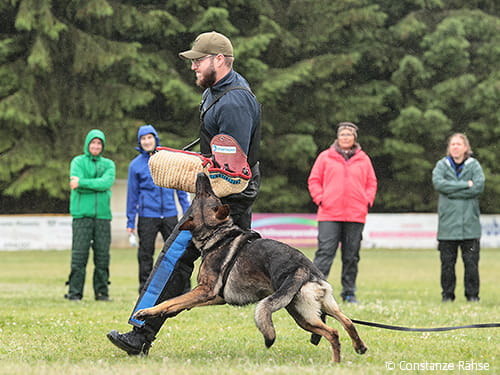
Letting the dog carry the sleeve does not help
By the way, Yannick is not a fan of the dog carrying around prey he has won. "If I have to teach a steady grip to a dog, I don't see the point in letting him run free with the sleeve. If he starts scrunching the sleeve, it's counterproductive. A dog always needs a job, so when he wins prey, a clearly defined job needs to follow. It shouldn’t be free choice."
Yannick also has a strong opinion in regards to countering. "I'm against countering in the vast majority of cases. There is a way of countering which I like very much: The dog’s having fun with it and really engaging with the helper and prey. I like that and I‘ll allow it, as long as it doesn't mess with the grips. But there is countering which I absolutely don’t approve of, and that is countering that has purposely been developed via negative reinforcement. The dog then thinks away from the helper. I don't like that at all. A dog that counters because it wants to get away from the helper is not doing the kind of protection work that I like to see. Countering also shouldn‘t end the game. We want the dog to run back back to the helper with the prey, jump at him, and clearly show us that he wants to re-engage."
Protection dog sports regularly receive criticism. To what level should aggressive behavior be encouraged? How does Yannick define the limit? "As always in life, we have to find a healthy middle ground. To push a dog so hard that he gets into defensive mode and feels like he needs to fight for his life makes no sense. That's not where we want to go and that's not where we should go. The goal has to be that the dog, the helper and the handler all end up enjoying what they're doing."
Good protection training is compliant with animal welfare
Germany’s recently introduced Animal Welfare Law amendment clearly states that you are not allowed not inflict pain on a dog during training. Is it a problem for Yannick to work without aversive corrections?
"No. A good trainer should be able to use all four quadrants of operant conditioning as the situation requires, and in an appropriate manner. As a trainer, you have to be accountable for the way you train: It is not ok to use positive punishment to correct something you wouldn’t have to correct in the first place if you hadn’t pushed the dog so hard that you lose control over him. That’s not a smart approach to training. If I build the foundation for impulse control from the beginning, if that is normal for the dog, then I don't even get into scenarios where drastic corrections would be required. I don't even have to go there if I spend the time to build a solid foundation first. And then our training is animal welfare compliant."

This approach also is the only way to present our sport in a positive light to the public. Knowledge creates responsibility. And that's where we as IGP helpers have to be accountable. An inexperienced handler won’t be able to tell when his dog is getting to a point where it is difficult to control. That's where we come in. That’s our responsibility.
"At that point, we have to stop protection training." Yannick clarifies. "We have to establish impulse control! And if it‘s lacking, then we have to build it up again. Only then can we continue with protection. If I only build up the dog‘s biting and drive levels, but I don‘t have control of him, then he will not compete successfully. So that can’t be the goal."
Wise words that conclude our interview! Many thanks to Yannick and Anne, from whom we will learn much more in the next article, for sharing their knowledge. If you have the opportunity to attend one of their workshops, don’t miss out – Yannick and Anne are even better in person.

